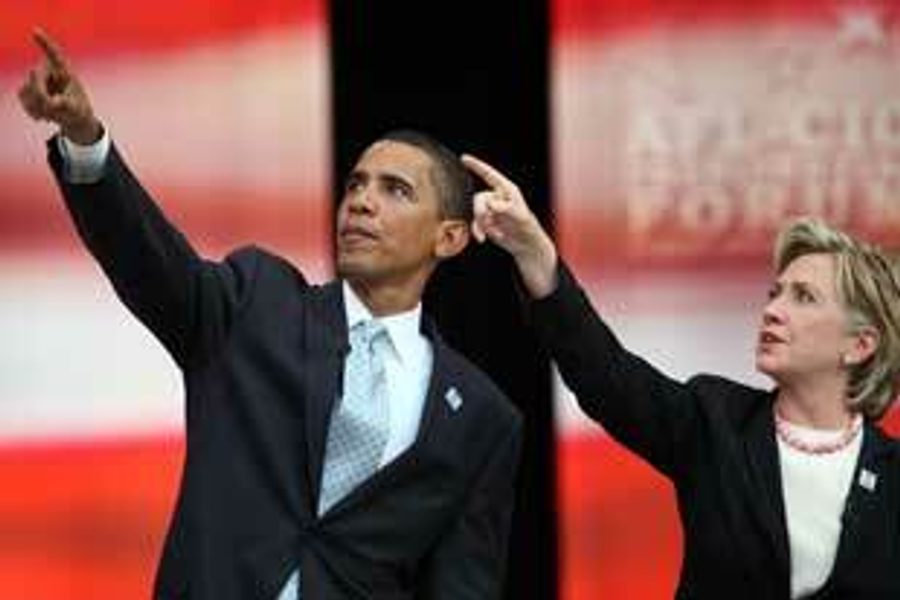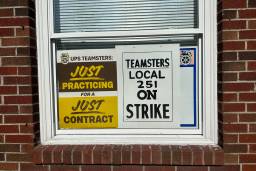Labor Split a Mixed Bag
Union threats to leave AFL-CIO generate waves, new possibilities
David Moberg

In the run-up to the AFL-CIO convention starting on July 25, observers have been avidly speculating about whether the Service Employees International Union (SEIU) or other unions in the Change to Win coalition challenging AFL-CIO President John Sweeney will leave the federation.
And if they do, what will that mean for the labor movement?
SEIU President Andy Stern has long talked of building “something stronger” than the AFL-CIO and he seems the most anxious of the dissidents to leave. The Laborers, another union in the coalition, have made it clear they plan to stay in. The executive boards of the remainder – UFCW (food and commercial workers), UNITE HERE (textile and hotel workers) and, just this week, the Teamsters – have voted to give their presidents the right to withdraw.
Many Teamsters, who have long been outside the AFL-CIO after their expulsion for ethical violations, have little love for the AFL-CIO in any case. But the smallest union, with ownership of a bank that relies heavily on union deposits and business, UNITE HERE has reasons to stay in. Still, both Bruce Raynor and John Wilhelm, the union’s two presidents, have harshly criticized Sweeney. Wilhelm’s resignation from chair of the immigration committee last week – over proposed immigration reform legislation, where the AFL-CIO has a strong position supporting worker rights – might be taken as a prelude to departure. And although UFCW had seemed among the least likely to leave, President Joe Hansen has recently made strong statements threatening departure.
All the leaders, except Stern, express reluctance to leave, and to some extent the threat of exit has been a way to force concessions when it seems unlikely that any challenger to Sweeney would have a chance. While Sweeney has offered compromises on many points – such as the amount of dues rebates provided to unions for organizing, or rules governing rights of unions to organize particular sectors of workers – the Change to Win unions have dismissed them as inadequate.
There’s a chance for last-minute negotiations, including the possibility of a ticket that embraces Wilhelm or Laborers president Terry O’Sullivan, but any compromise appears remote. Indeed, some Change to Win unions, who would have to pay back dues to attend the convention, may decide not even to participate.
Fallout from the split
The Sweeney forces have argued that a split would be disastrous for labor. But beyond the abstract call for unity, what would be the fallout of a major split?
First, John Sweeney’s prestige and ability to present himself as spokesman for America’s unions will suffer a damaging blow, but labor might benefit from having more spokespeople and identifiable leaders, even with the risk of some divergent messages.
More important, it would mean much less money for the AFL-CIO, a loss not only of dues but also part of the income from a union credit card deal, putting at risk roughly a quarter of its income and many jobs at the federation. Sweeney has already announced cutbacks of more than 100 positions, even without any unions leaving. At the state and local level, federations and central labor councils would also lose money, but currently, not all unions pay dues at those levels anyway. And many central labor councils are trying to figure out ways to cooperate with departing unions, even if AFL-CIO rules are enforced.
But the money that any unions pulling out of the AFL-CIO save on dues will not be so large as to make a big difference in the amount of organizing they will undertake. And if they make Change to Win into a federation, they will also have to pay for at least some staff.
But beyond a loss of money, a split could undermine the cooperation that has grown at the state and local levels – as well as the political coordination at the national level, which has led to a more sophisticated and effective program to educate and mobilize members. Having two federations lobbying politicians could lead to mixed, weakened messages from organized labor. But then again, at the level of policies and candidates, unions have gone their own way on endorsements in many cases despite the unified AFL-CIO machinery.
The greatest risk to the labor movement will probably come from heightened warfare among unions in the form of raiding and conflicts over organizing and deliberate undercutting of rivals. This could consume huge amounts of resources and give the public an unfavorable impression of unions. Also, employers and Republican operatives will undoubtedly try to play up divisions as much as possible.
“The impact in the end would be that people in labor will fight each other,” argued one skilled trades union official who supports Sweeney. “It’s a triumph of egotism over solidarity.”
Pointing to the organizing gains made when the AFL and CIO were separate and competing from 1935 to 1955, some argue that competition might produce more organizing. But during that earlier period there was already an upsurge of worker organization and a sympathetic administration encouraging unionization – hardly the conditions that exist today.
The flipside
It’s also worth remembering that the labor movement has rarely been completely united under one umbrella anyway. (And in many other industrial countries, such as France and Italy, there are multiple labor federations that are typically divided along political lines, but usually under conditions that are more favorable, both legally and politically, to unions.) The nation’s biggest union – the National Education Association – is outside the AFL-CIO today, as are a number of smaller unions, as well as the Carpenters, who are now part of the Change to Win coalition. In 1969, the United Auto Workers left the AFL-CIO and formed the ill-fated Alliance for Labor Action with the Teamsters. Such lapses of “unity” have not been disastrous, even if they have occasionally weakened union influence.
Also, unions within the AFL-CIO aren’t always united on organizing or political strategy, and they often do little to help each other in fights. Even within the Change to Win coalition, SEIU and UNITE HERE have made it a major point to work with environmental groups, while the Teamsters (and to a slightly lesser degree, the Laborers) were very public opponents of one of the environmentalists’ top legislative priorities: stopping drilling in the Alaska National Wildlife Refuge.
Even keeping the AFL-CIO together won’t mean labor unity. Rather than see the choice as one between splitting or maintaining the federation, the real challenge is for labor to move in a new direction of greater mutual collaboration. Perhaps the model should be Jobs With Justice, the labor-community coalition that asks members to pledge “to be there” at least five times a year for some other group of workers. (Ironically, 10 years ago the Sweeney administration temporarily thought central labor councils could replace Jobs with Justice.) Such pledges of cross-union solidarity would be a good start for the AFL-CIO, and indeed the Change to Win unions hope to realize the potential of such cooperation among themselves.
But there is also very little that the Change to Win unions can do on their own that they couldn’t do by remaining within the AFL-CIO. If they want to work together more closely, which makes sense for all of the affiliates, they can do so either formally through the AFL-CIO, through their Change to Win formation or informally with anyone else. But splitting from the AFL-CIO might make it harder to forge new, productive relationships.
In the end, even though any split would be big news – and ultimately bad news in that it would reflect labor’s inability to forge a common strategy – it need not be a disaster. Then again, with enough ill will, even that is a possibility.
David Moberg, a former senior editor of In These Times, was on staff with the magazine from when it began publishing in 1976 until his passing in July 2022. Before joining In These Times, he completed his work for a Ph.D. in anthropology at the University of Chicago and worked for Newsweek. He received fellowships from the John D. and Catherine T. MacArthur Foundation and the Nation Institute for research on the new global economy.








